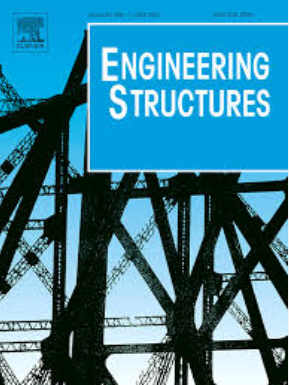Modal parameter changes as function of drift in two shear wall buildings
IF 5.6
1区 工程技术
Q1 ENGINEERING, CIVIL
引用次数: 0
Abstract
Seismic damage generally causes changes in the stiffness and energy dissipation characteristics of a building, which in turn affect its modal parameters and overall dynamics response It has also long been recognized that amplitude of the response, without damage, also produced changes in the apparent modal characteristics. Understanding and quantifying the modal variations are key for Seismic Structural Health Monitoring systems that want to distinguish between normal behavior and damage particularly if low-level damage detection is an objective. Two building structures that have been continuously monitoring and have registered together more than 1800 earthquake motions, most of them weak or medium but one event that generated maximum accelerations of 0.14 and 0.16 g at their base and up to 0.31 and 0.47 g on the structures causing damage. The database of events enables the identification of its modal properties and variations during both small, non-damaging events and a damaging event. Analysis shows that there is a clear amplitude dependent nonlinear response that can be captured by the variations of the periods as a function of building drift amplitude. These periods variation can be in the order of 20 % for a roof drift ratio of 0.1 % without any damage to these structures. A strong change in modal parameters can be observed in these structures after 0.1 % drift. After damage has occurred, the modal properties change as a function of drift with a different pattern when compared with the previous state of the structure. For the same drift, modal parameters in the damage state have a much larger mean (longer periods) and larger variation around the mean due to ambient conditions. The amplitude and sensitivity to drift of these changes are unique to each system and can be captured using non damaging event if a window base system identification technique is used. The amplitude variations that are not related to damage are determined and are later used on their respective autonomous structural health monitoring system.
求助全文
约1分钟内获得全文
求助全文
来源期刊

Engineering Structures
工程技术-工程:土木
CiteScore
10.20
自引率
14.50%
发文量
1385
审稿时长
67 days
期刊介绍:
Engineering Structures provides a forum for a broad blend of scientific and technical papers to reflect the evolving needs of the structural engineering and structural mechanics communities. Particularly welcome are contributions dealing with applications of structural engineering and mechanics principles in all areas of technology. The journal aspires to a broad and integrated coverage of the effects of dynamic loadings and of the modelling techniques whereby the structural response to these loadings may be computed.
The scope of Engineering Structures encompasses, but is not restricted to, the following areas: infrastructure engineering; earthquake engineering; structure-fluid-soil interaction; wind engineering; fire engineering; blast engineering; structural reliability/stability; life assessment/integrity; structural health monitoring; multi-hazard engineering; structural dynamics; optimization; expert systems; experimental modelling; performance-based design; multiscale analysis; value engineering.
Topics of interest include: tall buildings; innovative structures; environmentally responsive structures; bridges; stadiums; commercial and public buildings; transmission towers; television and telecommunication masts; foldable structures; cooling towers; plates and shells; suspension structures; protective structures; smart structures; nuclear reactors; dams; pressure vessels; pipelines; tunnels.
Engineering Structures also publishes review articles, short communications and discussions, book reviews, and a diary on international events related to any aspect of structural engineering.
 求助内容:
求助内容: 应助结果提醒方式:
应助结果提醒方式:


